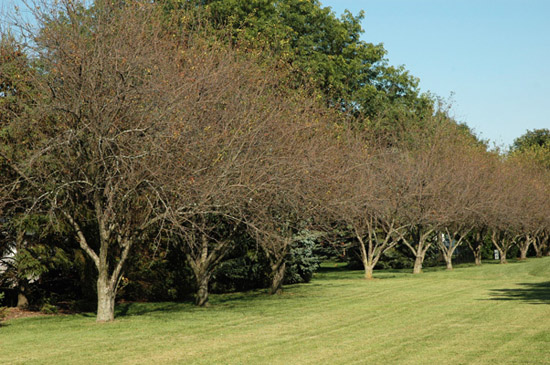Issue 2, April 30, 2010
Crabapple Scab Scenario?
Crabapple scab was more severe in 2009 than I have seen it in the past 20 years. The image shows an infected row of defoliated crabapples in early September, 2009 when other deciduous trees are still green.

The big question is whether we will see this much injury in 2010. Requirements for a disease problem are a susceptible host, a virulent pathogen, and the proper environment for infection. Most of you have seen this portrayed as a disease triangle. As evidenced by last year's infection, we have many susceptible trees. The pathogen, Venturia inaequalis, was plentiful in 2009 and over-winters in fallen leaves, buds, and twig cankers. Raking and removing leaves will help reduce infections, but there should be more than adequate pathogen in the landscape from last year. As usual, the bottom line is weather.
There are two types of spores that may cause this disease. Ascospores are the overwintering spores that infect in the spring, usually through petal fall. Central Illinois crabapples are almost finished with flowering for this season. Lesions that result from this primary infection will also produce spores which are called summer spores or conidia. This secondary infection will continue as long as rain events occur in summer and autumn. Infection requires a period of wetness. The length of time of wetness is related to temperature. At 50 degrees (F), ascospores need 14 hours of continuous leaf wetness to infect; and conidia need 11 hours of continuous wetness to infect leaves. At 60 degrees (F) only 9 hours and 6 hours of continuous wetness respectively are required for infection. Consult the Illinois report on plant disease No. 803, "Apple and Crabapple Scab" for more detail. If you saw the problem last year and wet periods are frequent, the disease will be a problem again.
Fungicides are used as preventives and must begin as buds first begin to open. University of Illinois recommendations state that the first spray should be applied when leaves just begin to emerge from buds (about one-quarter inch green). This is to protect new leaves. Sprays must be continued according to label intervals until two weeks after petal fall to give maximum protection against ascospore infection.
Many crabapple cultivars have resistance to scab, and resistance is definitely the long-term solution to infection. If you are planting new crabapples this year, look for varieties with resistance to scab, rust, fire blight, and powdery mildew. A publication that may help is this reference by U of I professors Dave Williams and Gary Kling: Recommended Crabapples for Illinois Landscapes (Adobe PDF). When looking at resistance options, look at ratings that have been made for your geographical area.--Nancy Pataky
Author:
Nancy Pataky